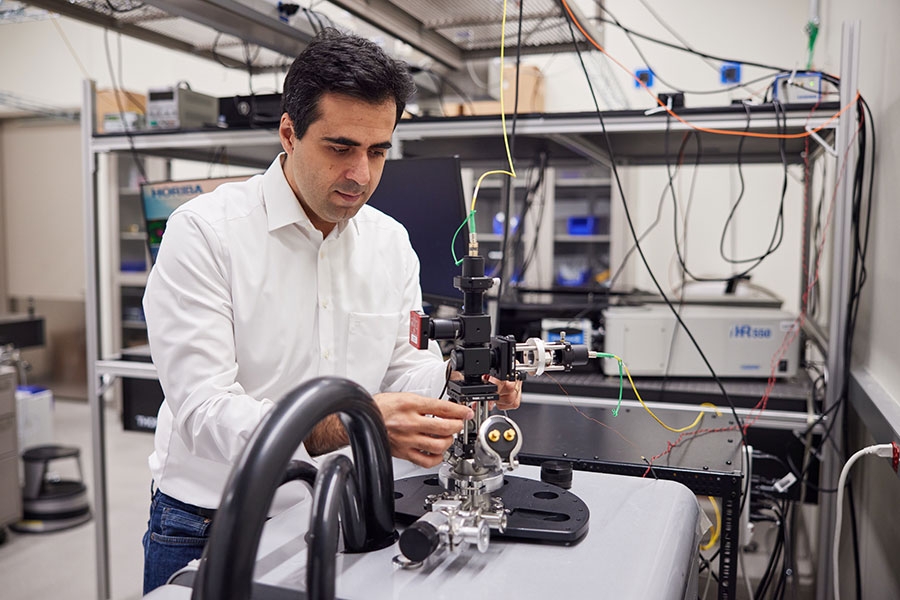
NORMAN, OKLA. – Alisa Javadi, Ph.D., professor at the University of Oklahoma School of Electrical and Computer Engineering and the Homer L. Dodge Department of Physics and Astronomy, has received funding from the U.S. Department of Energy Early Career Research Program for research that offers the potential for advancing quantum technology development.
Javadi’s research will test the use of cerium oxide as a host for quantum bits, or qubits. Qubits, the building blocks of quantum computing, need an environment free of magnetic noise to function properly. Isotopic purification, which removes magnetic nuclei, is the only guaranteed solution, but it is costly. Currently, diamond is the leading material for quantum emitters. However, diamonds are expensive and contain magnetic carbon atoms, which require further isotopic purification.
Javadi’s project explores a promising alternative. Cerium oxide is made of cerium and oxygen, which both lack magnetic nuclei. By providing a noise-free environment, it is an ideal candidate for hosting qubits. Javadi says that this project will contribute to the progress of photonic quantum technologies and that these discoveries could significantly impact a broad range of disciplines, such as secure communication technologies and biology.
The study's first phase will focus on identifying color centers, or optically active quantum bits, and understanding their properties. Color centers are typically arrangements of extrinsic atoms in the host, atoms that are not native to the host. The team will use theoretical studies to narrow the search for the right combination of these atoms to a handful of candidates. They will then grow the host crystals through pulsed laser deposition, a technique that allows for testing with short turnaround times. The team will then conduct room-temperature and cryogenic studies to test the photon emission from these color centers and validate the theoretical predictions.
The project will also explore the role that geometry plays in the optical emission of ensembles of emitters. One phenomenon of interest is superradiance, where quantum emitters work collectively to generate bursts of energy. Javadi will compare how geometry influences superradiance in different forms of arrangement of emitters, including a three-dimensional crystal and a two-dimensional sheet.
Javadi earned his doctoral degree from the Niels Bohr Institute at the University of Copenhagen. He was a postdoctoral researcher at the University of Copenhagen and at the University of Basel. He has received a European Research Council Starting Grant and the Marie Skłodwska-Curie Postdoctoral Fellowship from the European Commission. His research interests include quantum sensing, communication and quantum light sources.
Learn more about Javadi’s research group here.
About the project
“Color Centers in Noise-Free Hosts for Quantum Sensing and Communication Applications” will receive $875,524 from the Office of Basic Energy Sciences and the Department of Energy’s Established Program to Stimulate Competitive Research. The project began on July 1, 2024 and will conclude on June 30, 2029.
About the University of Oklahoma
Founded in 1890, the University of Oklahoma is a public research university located in Norman, Oklahoma. As the state’s flagship university, OU serves the educational, cultural, economic and health care needs of the state, region and nation. For more information about the university, visit www.ou.edu.
Three University of Oklahoma graduate students have been named winners of the 2025 Three Minute Thesis competition, which challenges participants to explain their research in three minutes to a non-specialist audience.
Sarah Sharif, a researcher with the University of Oklahoma, has been awarded funding from the U.S. Department of Defense (DoD) to create innovative light detectors that pick up mid-wave and long-wave infrared signals at higher temperatures than previously considered achievable.
A team from OU and WVU recently earned a five-year, $3.5 million grant from the National Institutes of Health to study how concept cigarillos influence the potential for addiction. The results will be used to inform the FDA’s impending flavor ban on cigar products and could have wider-reaching implications for other tobacco products that come in flavors, such as e-cigarettes and tobacco-free nicotine pouches.